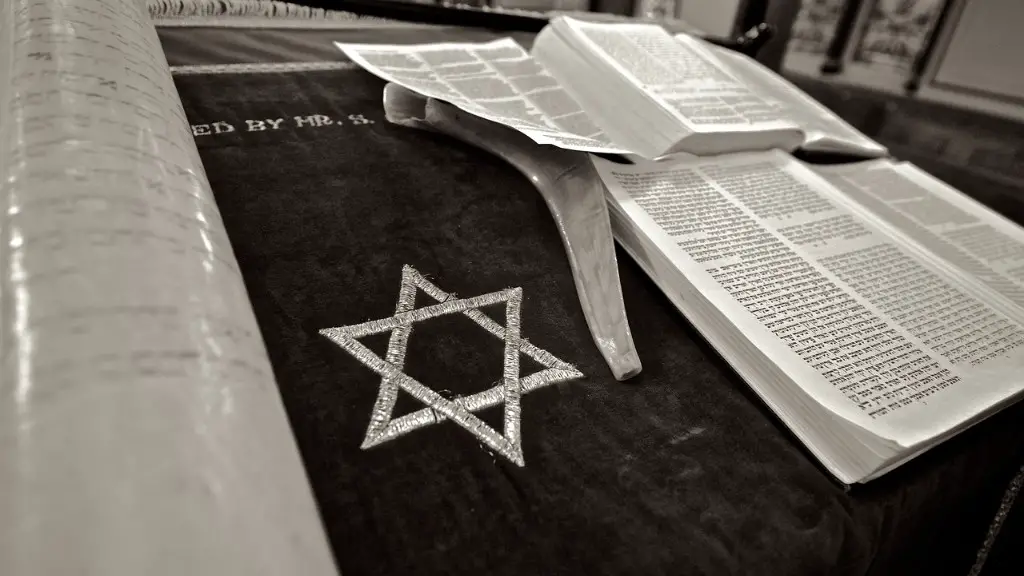Judaism is a religion originating from the ancient Hebrews of the Middle East. It is one of the oldest religions in the world, with over fourteen million followers around the world. A religion’s holy book is usually a source of its teachings, beliefs and rituals. In Judaism, the holy book is known as the Tanakh or the Hebrew Bible.
The Tanakh is an acronym of the three main sections of the Hebrew Bible. These sections are Torah (the Five Books of Moses), Neviim (Prophets) and Ketuvim (Writings). The books of the Tanakh were composed in the ancient Hebrew language and were written by prophets and priests over a period of about one hundred years.
The Tanakh is an important part of Jewish life as it is the Jewish holy writings that guide and instruct Jews on how to live their lives according to the laws of the religion. It is used in the education of young Jews and serves as the basis for religious understanding. The Tanakh provides insight into the history and culture of the Jewish people, as well as insights into life and death, creation and redemption.
The Tanakh is divided into the three sections; Torah, Prophets and Writings. The Torah contains the major teachings of Judaism such as the Ten Commandments and other commandments. The Prophets focuses mainly on the teachings of the prophets such as Isaiah and Jeremiah, while the Writings contain a variety of texts such as the books of Psalm and Proverbs.
The Tanakh is an important religious text for Jews, as it tells the story of their history and provides guidance on how to properly live a Jewish life. It is a source of inspiration and understanding for many Jews around the world and is essential for living a Jewish life.
What Is the Relationship Between the Hebrew Bible and the Christian Bible?
The Tanakh and the Christian Bible are related but different in many ways. The Hebrew Bible is the basis for the Old Testament, which Christians refer to as the Christian Bible. The Tanakh and the Christian Bible contain many of the same books and stories, but the Christian Bible contains some books and stories not found in the Tanakh.
The Tanakh, or Hebrew Bible, has 39 books which make up the Old Testament. The Christian Bible has the same books and stories, but it also has a section called the New Testament, which contains books written by authors not found in the Tanakh. The New Testament is comprised of 27 books written by early Christian authors.
The relationship between the Tanakh and the Christian Bible is significant because it shows how the two religions, Judaism and Christianity, influenced each other. The Jewish authors of the Tanakh had a direct influence on the New Testament authors. The books of the Tanakh have been a source of inspiration and knowledge for both religions throughout the centuries.
How Can The Tanakh Be Used In Daily Life?
The Tanakh can be used in many ways to enrich our lives both spiritually and emotionally. It can provide guidance on how to live our lives according to the teachings of the faith. Studying the Tanakh can provide us with a deep understanding of the Jewish faith and its beliefs. It can also provide answers to difficult questions and a sense of comfort in times of despair.
The Tanakh can help us to understand our relationship with God and our place in the world. The teachings of the Hebrew Bible can offer comfort and hope during times of despair, sadness and confusion. It can provide us with a moral compass that can help us to make the right decisions and to find meaning in our lives.
Reading and studying the Tanakh can provide us with the understanding that we are all connected to each other and to God, and that we are part of something greater than ourselves. It can also help us to find strength in difficult times and to find joy in the good times. It can be a source of spiritual growth and understanding, a source of comfort and solace.
How Do Jews View The Tanakh?
Jews view the Tanakh as divine in origin, as a gift from God to the Jewish people. The Tanakh is viewed as the main source of the Jewish religion and the linchpin of Jewish culture. It is believed that it contains the words of God, while other parts of the Bible contain words of wisdom, instruction and advice.
The Tanakh is viewed as containing God’s law and guidance for how Jews should live. It is viewed as authoritative and trustworthy, containing teachings and instructions from God. Jews look to the Tanakh for understanding and spiritual guidance, as it is believed to contain the word of God.
The Tanakh is viewed as a source of Jewish identity and culture, as it contains the Scriptures and the histories of the Jewish people. It is seen as a source of inspiration and education about the Jewish faith and its history. Jews view it as a sacred text, and it is given great honor and respect.
What Is The Source Of The Tanakh?
The Tanakh is believed to have been written by the ancient Hebrews, dating back to the time of King David. It is believed that the Torah, or Five Books of Moses, were written by Moses himself in the 14th century BCE. These books are believed to have been transmitted orally until they were written down and compiled in the 8th century BCE.
The other books of the Tanakh, such as the Prophets and Writings, are believed to have been written mostly by the prophets of Israel in the 6th through the 2nd centuries BCE. It is believed that these books were collected during this time and served as the basis for the Tanakh.
The Tanakh is believed to have been compiled and edited during the period of the Second Temple, which began around 538 BCE and ended with the destruction of the Temple in 70 CE. Since then, the Tanakh has been translated into modern languages from the original Hebrew and has served as the source of Jewish religious practice.
How Is The Tanakh Used In Jewish Liturgy?
The Tanakh is used in many aspects of Jewish worship and religious practice. It is often read aloud during services, as it is seen to contain the words of God. Many prayers, songs and blessings also refer to stories and passages from the Tanakh.
The Tanakh is also used in ritual life. Many rituals such as a circumcision or a wedding traditionally involve certain passages and prayers from the Tanakh. The Torah is read aloud during services in many synagogues, and it is believed by many to contain the words of God.
The Tanakh is also studied and interpreted in Jewish life. Jewish scholars often study the text of the Tanakh for insights into the faith and for spiritual understanding. Also, tikkun olam, or ‘repair of the world’, is often interpreted as having a basis from the teaching of the Tanakh.
How Does The Tanakh Shape Jewish Identity?
The Tanakh is a source of Jewish beliefs, as it contains the main teachings of Judaism. It is seen as a source of Jewish identity, as it contains information about the Jewish people and their history. It is seen as language of the Jewish people, as it contains prayers, songs and blessings in the Hebrew language.
The Tanakh is seen as a connection between the divine and the Jewish people. It is seen as providing insight into the relationship between God and the Jewish people. It is also seen as a symbol of the covenant relationship between God and the Jewish people.
The Tanakh shapes Jewish traditions and practices, as it is studied and interpreted for insights into the faith. The stories, characters and teachings of the Tanakh are seen to have a direct influence on Jewish life and culture. The Tanakh is seen as connecting the Jewish people to the teachings of their faith and to the divine.
Conclusion
The Tanakh, also known as the Hebrew Bible, is the holy book of Judaism. It is a source of teachings, beliefs and rituals, and is an important part of Jewish life. It is used in the education of young Jews, and it provides insight into the history and culture of the Jewish people. The Tanakh is believed to have been written by the ancient Hebrews and it is seen as containing the words of God. It is used in many aspects of Jewish worship and religious practice, and it shapes Jewish identity. It is a source of spiritual growth, comfort and understanding for Jews around the world.


